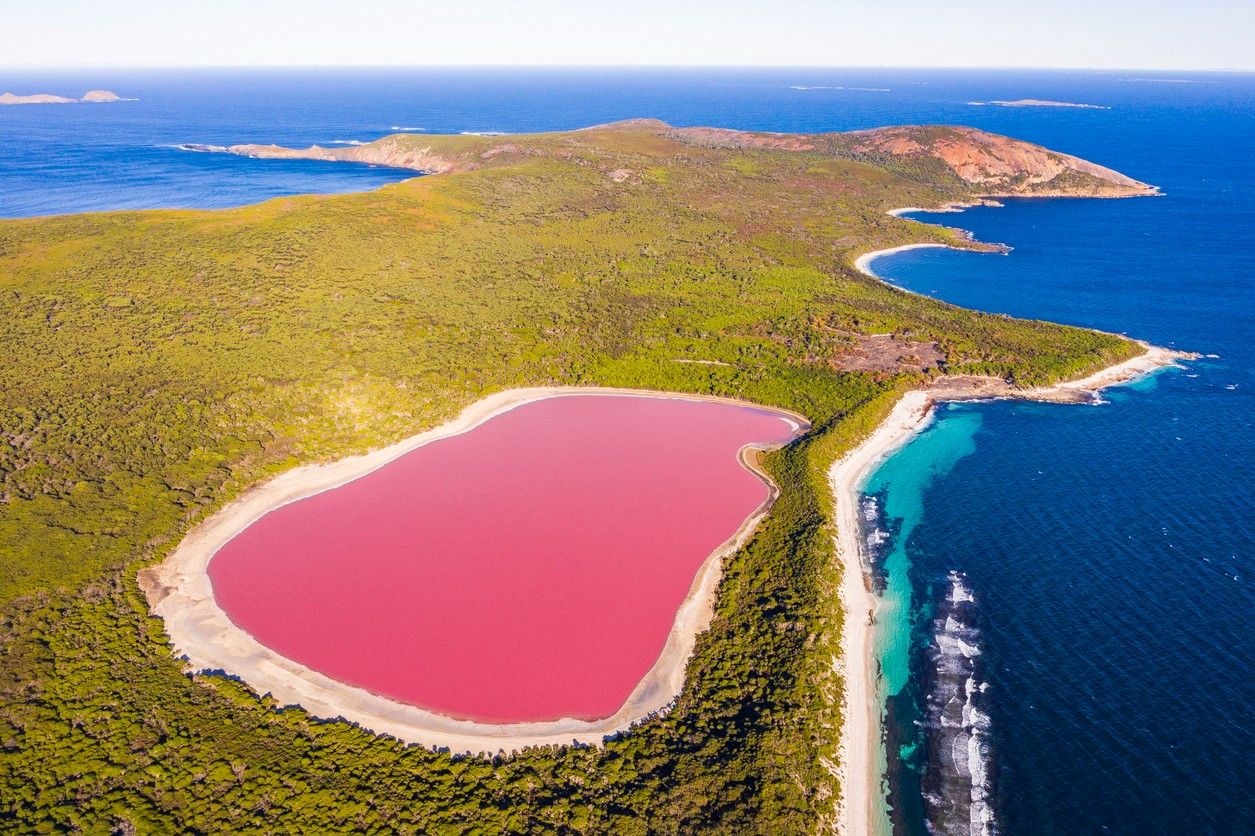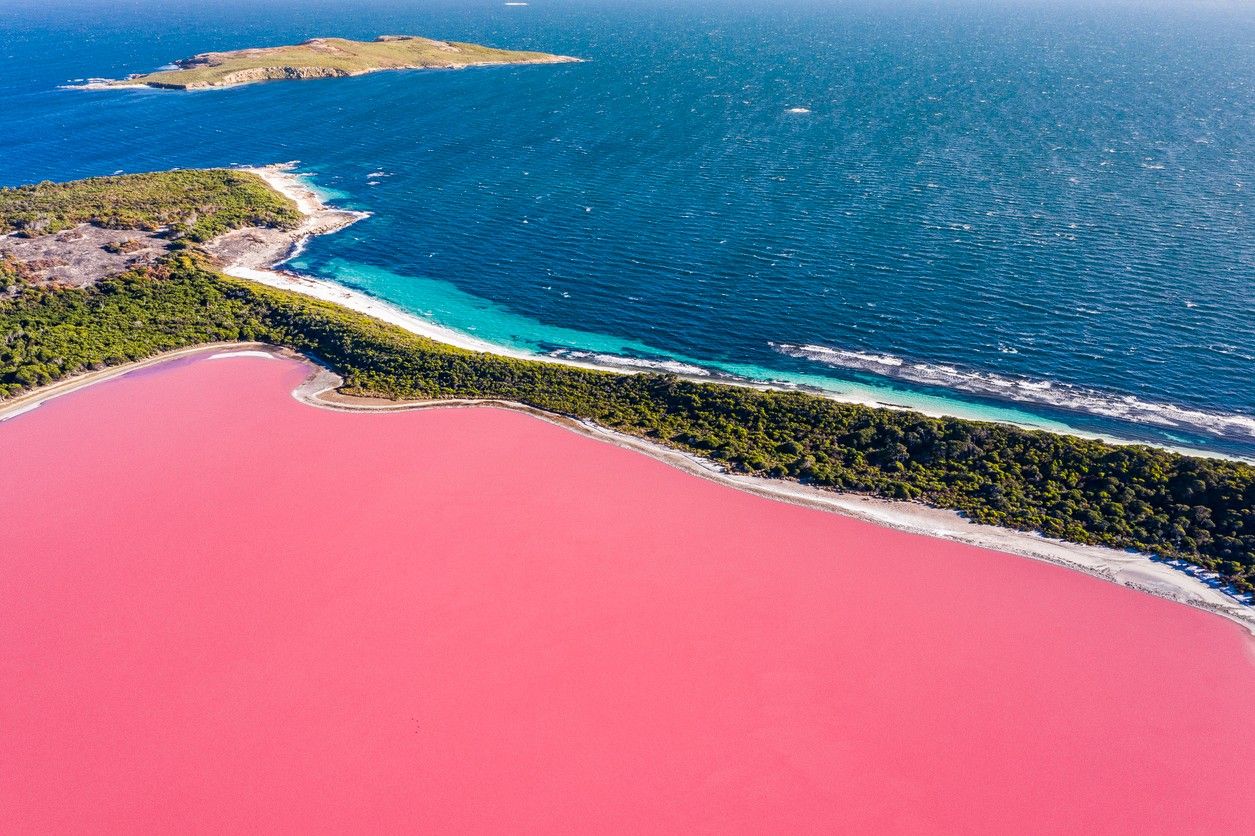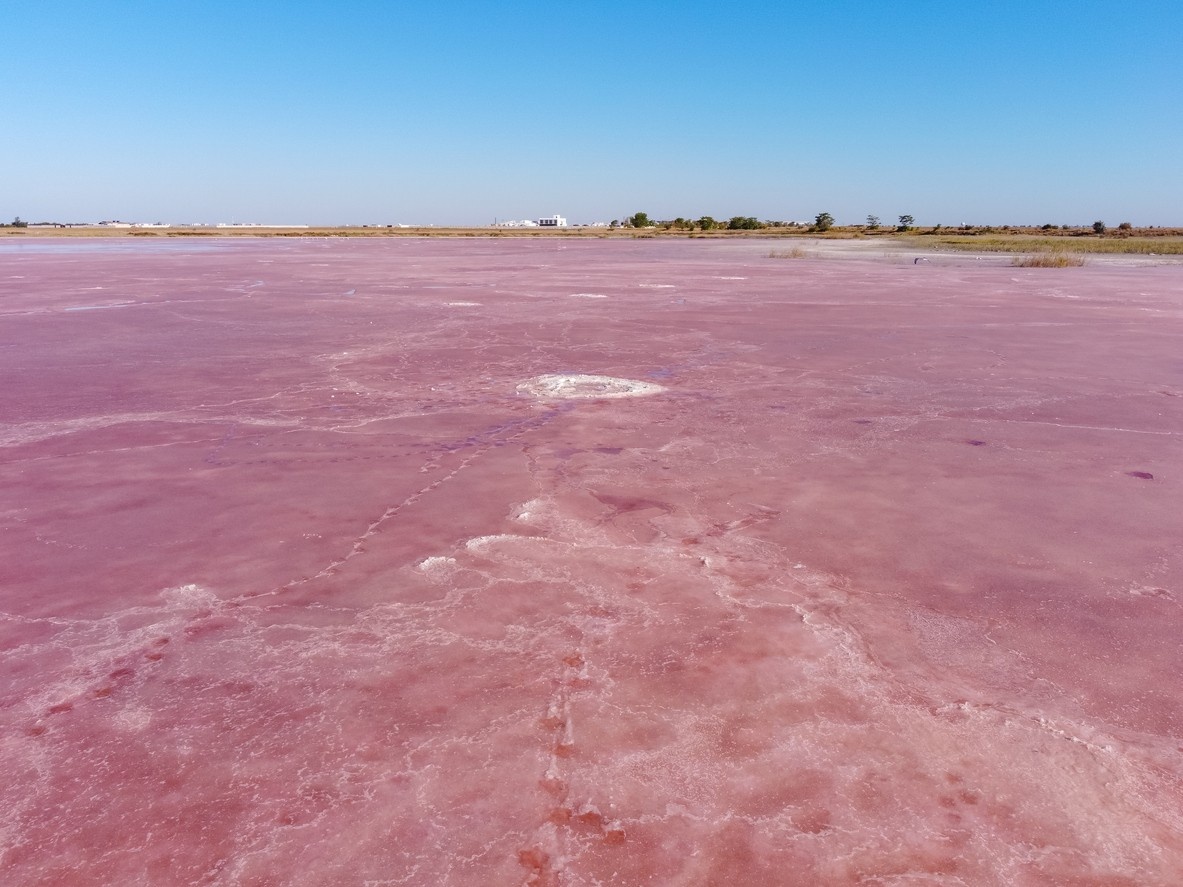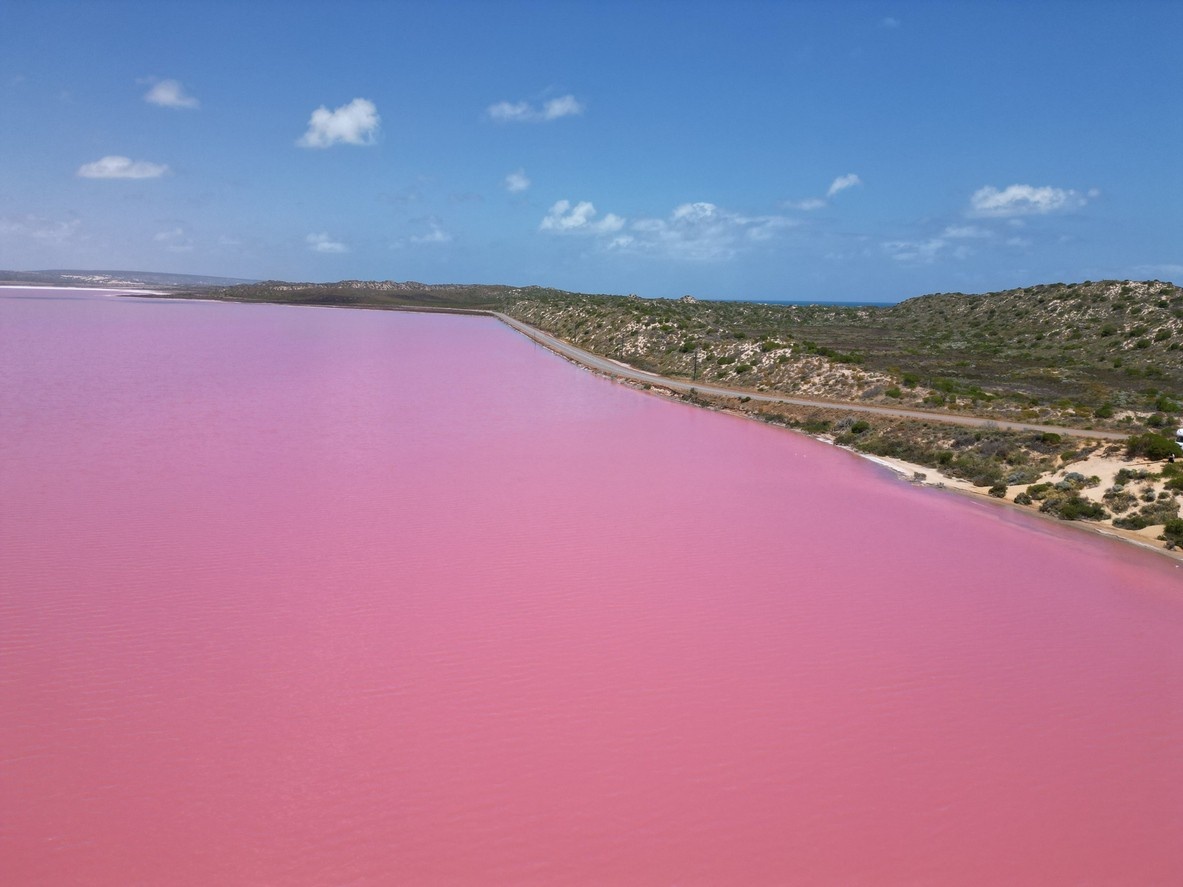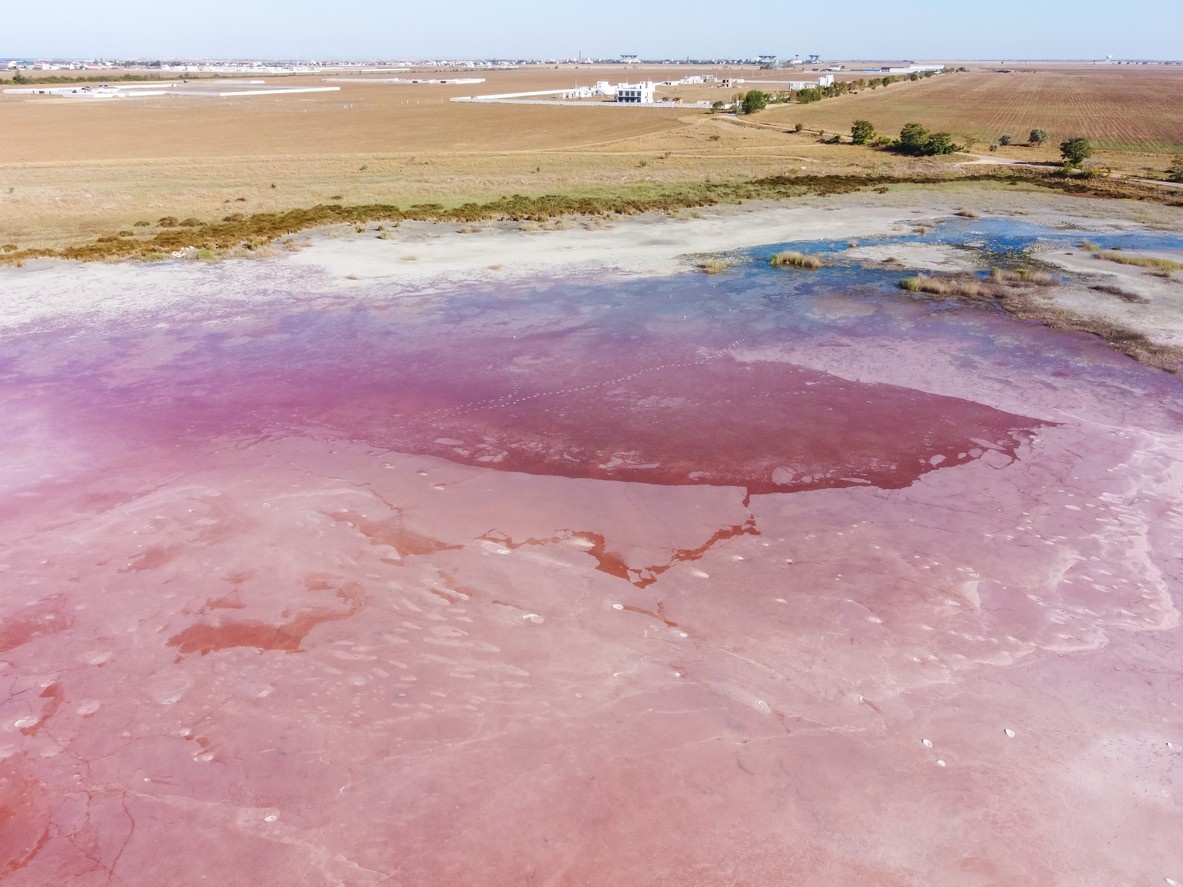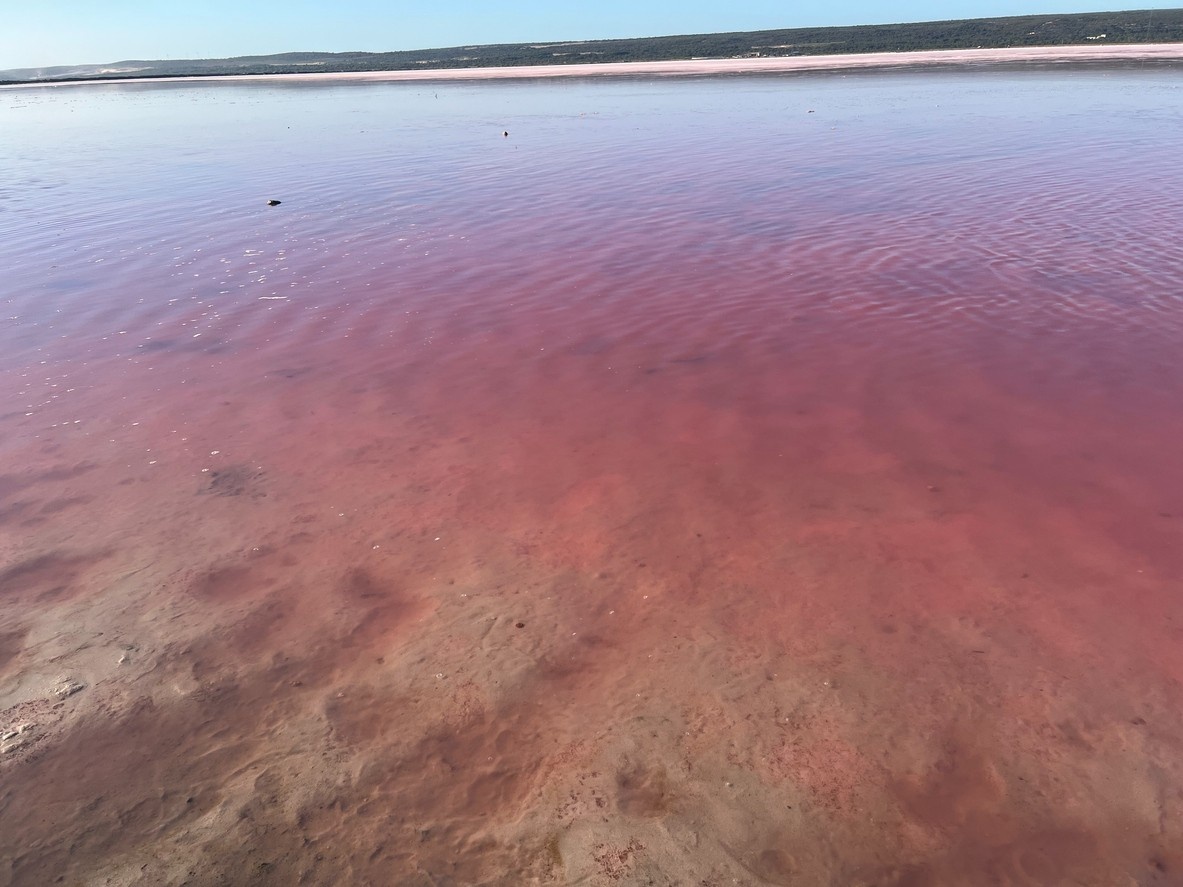Lake Hillier, a mesmerising natural wonder, is a vibrant pink-coloured lake located on Middle Island, the largest of the islands and islets that make up the Recherche Archipelago in Western Australia. This unique lake has captured the attention of travellers, scientists, and nature enthusiasts from around the world due to its striking colour and picturesque setting. The lake's distinctive pink hue is a result of the presence of a specific type of microalgae called Dunaliella salina, which thrives in the lake's highly saline environment. These microorganisms produce carotenoids, which are pigments that create the lake's extraordinary colour. Lake Hillier is situated approximately 130 kilometres east of Esperance, a coastal town in Western Australia known for its stunning beaches and natural beauty. Despite its remote location, the lake has become a popular tourist attraction, drawing visitors who are eager to witness its remarkable colour firsthand. The lake's unique characteristics and stunning visual appeal have also made it a subject of scientific interest, with researchers studying the microorganisms and environmental factors that contribute to its distinctive hue. In this article, we will delve into the various aspects of Lake Hillier, including its location, history, scientific significance, and the best ways to experience this extraordinary natural wonder in Western Australia.
The Discovery & History of Lake Hillier
Lake Hillier was first discovered by the British navigator and cartographer Matthew Flinders on 15 January 1802 during his expedition aboard the HMS Investigator. Flinders went ashore on Middle Island, the largest of the islands in the Recherche Archipelago off the southern coast of Western Australia, and climbed to the highest peak, which is now named Flinders Peak after him. From this vantage point, he noticed "a small lake of a rose colour" to the northeast, which he named Lake Hillier after William Hillier, a crew member who had died of dysentery shortly before. Flinders and his crew investigated the lake more closely and found that it was almost as salty as the Dead Sea. They collected salt from the shores of the lake to replenish their ship's supplies. In his journal, Flinders wrote: "In the north-eastern part was a small lake of a rose colour, the water of which, as I was informed by Mr Thistle who visited it, was so saturated with salt that sufficient quantities were crystallised near the shores to load a ship. The specimen he brought on board was of good quality and required no other process than drying to be fit for use."
For a brief period in the late 19th century, Lake Hillier was used for commercial salt mining. In 1889, Edward Andrews investigated the potential of producing salt from the lake and moved onto Middle Island with his two sons for about a year. However, the salt mining venture failed, possibly due to the toxicity of the salt collected for consumption. There have been no further attempts to mine salt from Lake Hillier since then. Today, Lake Hillier is protected as part of the Recherche Archipelago Nature Reserve and access to Middle Island is restricted. The lake is mainly a tourist attraction, with visitors able to view its distinctive pink colour from the air or cruise ships. On rare occasions, tourists may be able to land on the island and see the lake from the shore, but swimming in the lake is not usually permitted.
The Science Behind Lake Hillier's Pink Colour
The striking pink colour of Lake Hillier has long been a subject of scientific curiosity. Researchers have studied the lake's unique ecosystem to understand the factors that contribute to its unusual hue. The primary cause of the lake's pink colour is the presence of a microorganism called Dunaliella salina, a type of halophilic (salt-loving) algae that thrives in the lake's highly saline environment. These microalgae produce carotenoids, which are natural pigments that create the lake's distinctive colour. Carotenoids are organic compounds that are found in various plants, algae, and bacteria. In Dunaliella salina, these pigments serve as a protective mechanism against the intense sunlight and high salinity of the lake's water. The carotenoids absorb excess light energy and prevent damage to the algae's cellular structures. The concentration of Dunaliella salina in Lake Hillier is particularly high due to the lake's unique environmental conditions. The lake has a high salinity level, which is maintained by the natural inflow of seawater through small channels and the evaporation of water from the lake's surface.
This creates an ideal habitat for the salt-loving microalgae to flourish. In addition to the presence of Dunaliella salina, other factors contribute to the lake's pink hue. The lake's shallow depth and high evaporation rate create a concentrated salt solution, which reflects light in a way that enhances the pink colour. The surrounding white salt deposits and the clear blue sky also play a role in creating a striking contrast that intensifies the lake's unique appearance. Scientists continue to study Lake Hillier and its ecosystem to better understand the complex interplay of microorganisms, environmental factors, and optical phenomena that create its remarkable pink colour. These studies not only shed light on the lake's unique characteristics but also contribute to our broader understanding of the diversity and adaptability of life in extreme environments.
Exploring Middle Island & Lake Hillier
Middle Island, the largest of the islands in the Recherche Archipelago, is home to the stunning pink-hued Lake Hillier. Exploring this unique natural wonder and its surrounding environment is an unforgettable experience for visitors to Western Australia.
Scenic Flights and Aerial Views
Scenic flights offer a breathtaking way to experience the beauty of the Great Barrier Reef and its surrounding islands from a unique aerial perspective. Several tour operators provide a variety of flight options, allowing visitors to choose the duration and route that best suits their interests and budget.
- 60-Minute Scenic Flights — One of the most popular options is the 60-minute scenic flight, which typically includes flyovers of the Whitsunday Islands, Great Barrier Reef, Heart Reef, Whitehaven Beach, and Hill Inlet. These flights provide ample time to take in the stunning vistas and capture incredible photographs of the iconic landmarks. Departing from various locations such as Airlie Beach and Hamilton Island, these flights offer a comprehensive overview of the region's natural wonders.
- Helicopter Tours — Helicopter tours provide a more intimate and exhilarating way to explore the Great Barrier Reef and its surroundings. Companies like Hamilton Island Air offer a range of helicopter experiences, including scenic flights, reef cruises, and island landings. These tours can be customised to include snorkelling, beach picnics, and even visits to the famous Heart Reef. One unique experience is the "Heart Island" tour, where visitors land on a floating pontoon moored near Heart Reef. From there, they can sail and snorkel around this naturally occurring heart-shaped reef after a stunning aerial journey. This exclusive experience is only accessible by helicopter, making it a truly unforgettable adventure.
- Combination Tours — For those seeking a comprehensive Great Barrier Reef experience, combination tours that include both scenic flights and boat cruises are available. These packages often feature a one-way helicopter flight, providing aerial views of the Whitsunday Islands, Whitehaven Beach, Hill Inlet, Heart Reef, and the outer reef, followed by a cruise back to the mainland. Alternatively, visitors can cruise first and then return via a scenic helicopter flight. These combination tours offer the best of both worlds, allowing visitors to enjoy the reef from above and below the water's surface.
Boat Tours and Island Landings
While scenic flights provide a bird's eye view of the Great Barrier Reef and its islands, boat tours and island landings offer a more immersive experience. Visitors can explore the underwater wonders of the reef, set foot on pristine beaches, and discover the unique flora and fauna of the islands.
- Cruise Whitsundays Reefworld — One popular destination for boat tours is the Cruise Whitsundays Reefworld pontoon, located on the outer Great Barrier Reef. Visitors can reach this floating platform by luxury catamaran, enjoying a scenic cruise through the Whitsunday Islands. Once at Reefworld, guests have approximately two hours to snorkel, view the colourful coral gardens, and enjoy a buffet lunch. Some tours also include a visit to the famous Whitehaven Beach, known for its pristine white silica sand.
- Whitehaven Beach Tours — Whitehaven Beach, with its stunning turquoise waters and white silica sand, is a must-see destination in the Whitsundays. Many boat tours include a stop at this iconic beach, allowing visitors to swim, relax, and explore the shoreline. Some tours also offer a guided walk to Hill Inlet, a stunning viewpoint that offers panoramic views of the swirling sands and crystal-clear waters. For a more exclusive experience, visitors can opt for a helicopter tour that lands directly on Whitehaven Beach. These tours typically include around 50-75 minutes on the beach, along with sparkling wine and water. The aerial journey to and from the beach provides breathtaking views of the surrounding islands and reefs.
- Island Hopping Tours — Island hopping tours allow visitors to explore multiple islands within the Whitsundays, each with its unique character and attractions. These tours often combine snorkelling, beach activities, and bushwalking, providing a well-rounded experience of the region's natural beauty. Some popular islands to visit include Hamilton Island, Hook Island, and Daydream Island, each offering a range of activities and accommodations. Guided tours can provide insight into the islands' ecology, history, and culture, enhancing the overall experience.
Scientific Research & Ecological Importance
The unique pink colour of Lake Hillier has made it a subject of scientific interest for decades. Researchers have studied the lake's microorganisms, particularly the Dunaliella salina algae, to better understand how they thrive in such a high-salinity environment and produce the carotenoid pigments responsible for the lake's distinctive hue. These studies have provided valuable insights into the adaptability and diversity of life in extreme environments. In addition to its microbiological significance, Lake Hillier plays a crucial role in the broader ecosystem of the Recherche Archipelago. The lake and its surrounding wetlands provide habitat for a variety of plant and animal species, some of which are endemic to the region. The archipelago is home to a diverse array of seabirds, marine mammals, and reptiles, many of which rely on the unique environmental conditions created by the lake and its surroundings. The study of Lake Hillier's ecosystem has also contributed to our understanding of the impacts of climate change and human activities on fragile environments. As global temperatures rise and sea levels change, monitoring the lake and its surrounding islands can provide valuable data on how these unique ecosystems respond and adapt to changing conditions. This information can help inform conservation efforts and management strategies to protect these valuable natural assets for future generation.
Cultural Heritage & Tourism
Lake Hillier and the Recherche Archipelago have a rich cultural heritage that spans thousands of years. The indigenous Noongar people have inhabited the region for over 40,000 years and have deep spiritual and cultural connections to the land and sea. The archipelago features prominently in Noongar Dreamtime stories and is considered a sacred site by many indigenous communities. European exploration and settlement of the region began in the early 19th century, with the archipelago playing a significant role in the region's maritime history. The islands were used as a base for whaling and sealing operations, and later for salt mining and other industrial activities. Today, the cultural heritage of the Recherche Archipelago is celebrated and protected through various initiatives, including the establishment of the Recherche Archipelago Nature Reserve and the recognition of indigenous land rights and cultural practices. Tourism has become an increasingly important aspect of the region's economy and cultural landscape. Visitors from around the world are drawn to the stunning natural beauty of Lake Hillier and the surrounding islands, as well as the unique wildlife and recreational opportunities they offer. Eco-tourism and cultural tourism initiatives have been developed to showcase the region's natural and cultural assets while promoting sustainable and responsible travel practices. By fostering a deeper appreciation and understanding of the region's significance, tourism can play a vital role in conserving and celebrating the unique heritage of Lake Hillier and the Recherche Archipelago for generations to come.
Protecting Lake Hillier & its Ecosystem
As a unique and fragile natural wonder, Lake Hillier and its surrounding ecosystem require careful management and protection to ensure their long-term health and sustainability. Various stakeholders, including government agencies, conservation organisations, and local communities, have recognised the importance of preserving this extraordinary environment for future generations.
Conservation Efforts & Environmental Management
The Recherche Archipelago, including Middle Island and Lake Hillier, is protected as part of the Recherche Archipelago Nature Reserve. This designation recognises the area's significant ecological, scientific, and cultural values and provides a framework for its management and conservation. The Western Australian Department of Biodiversity, Conservation and Attractions (DBCA) is responsible for managing the reserve and implementing conservation strategies to protect its unique flora, fauna, and ecosystems. These efforts include monitoring wildlife populations, controlling invasive species, and managing human activities to minimise their impact on the environment. In addition to government-led initiatives, non-profit organisations and community groups also play a crucial role in conserving Lake Hillier and its surroundings. These groups work to raise awareness about the importance of protecting the archipelago, engage in research and monitoring projects, and support sustainable tourism practices that minimise the environmental footprint of visitors to the area. One key aspect of environmental management in the Recherche Archipelago is the promotion of responsible tourism. Visitors to Lake Hillier and the surrounding islands are encouraged to follow best practices for minimising their impact, such as staying on designated trails, properly disposing of waste, and avoiding disturbance to wildlife and habitats. Tour operators and local businesses are also encouraged to adopt eco-friendly practices and contribute to conservation efforts through education and stewardship programs.
Balancing Tourism & Sustainability
As Lake Hillier continues to gain popularity as a tourist destination, it is crucial to strike a balance between promoting visitation and ensuring the long-term sustainability of the ecosystem. Overexploitation and uncontrolled tourism can lead to degradation of the environment, loss of biodiversity, and diminished visitor experiences. To address these challenges, stakeholders in the region are working to develop and implement sustainable tourism strategies that prioritise the conservation of Lake Hillier and its surroundings. These strategies may include:
- Limiting visitor numbers and access to sensitive areas to reduce the environmental impact of tourism.
- Developing infrastructure and facilities that minimise the ecological footprint of visitors, such as eco-friendly accommodations and waste management systems.
- Promoting responsible tourism practices through education and interpretation programs that foster a deeper appreciation and understanding of the region's natural and cultural values.
- Supporting local communities and businesses that adopt sustainable practices and contribute to conservation efforts.
- Monitoring the impacts of tourism on the environment and adapting management strategies as needed to ensure the long-term health and resilience of the ecosystem.
By prioritising sustainability and responsible tourism, the unique beauty and ecological significance of Lake Hillier can be preserved for generations to come, while still allowing visitors to experience and appreciate this extraordinary natural wonder.
Visiting Lake Hillier: Location and Accessibility
Lake Hillier is located on Middle Island, the largest island in the Recherche Archipelago off the southern coast of Western Australia. The island is situated approximately 130 kilometres east of Esperance, a coastal town known for its stunning beaches and natural beauty. Despite its remote location, there are several ways to visit Lake Hillier and experience its unique pink colour firsthand.
Getting to Esperance — To reach Lake Hillier, visitors must first travel to Esperance, which serves as the gateway to the Recherche Archipelago. Esperance is accessible by road, air, and sea. By road, Esperance is approximately 720 kilometres southeast of Perth, the capital city of Western Australia. The drive takes around 8 hours along National Highway 1 and State Route 40. For those preferring to fly, Esperance Airport (EPR) is serviced by regular flights from Perth, operated by Regional Express (REX). The flight duration is approximately 1 hour and 40 minutes. Alternatively, visitors can reach Esperance by sea, with cruise ships occasionally making port calls in the town.
Related Articles

Let us know you agree to cookies
We use marketing, analytical and functional cookies as well as similar technologies to give you the best experience. Third parties, including social media platforms, often place tracking cookies on our site to show you personalised adverts outside of our website.
We store your cookie preferences for two years and you can edit your preferences via ‘manage cookies’ or through the cookie policy at the bottom of every page. For more information, please see our cookie policy.
